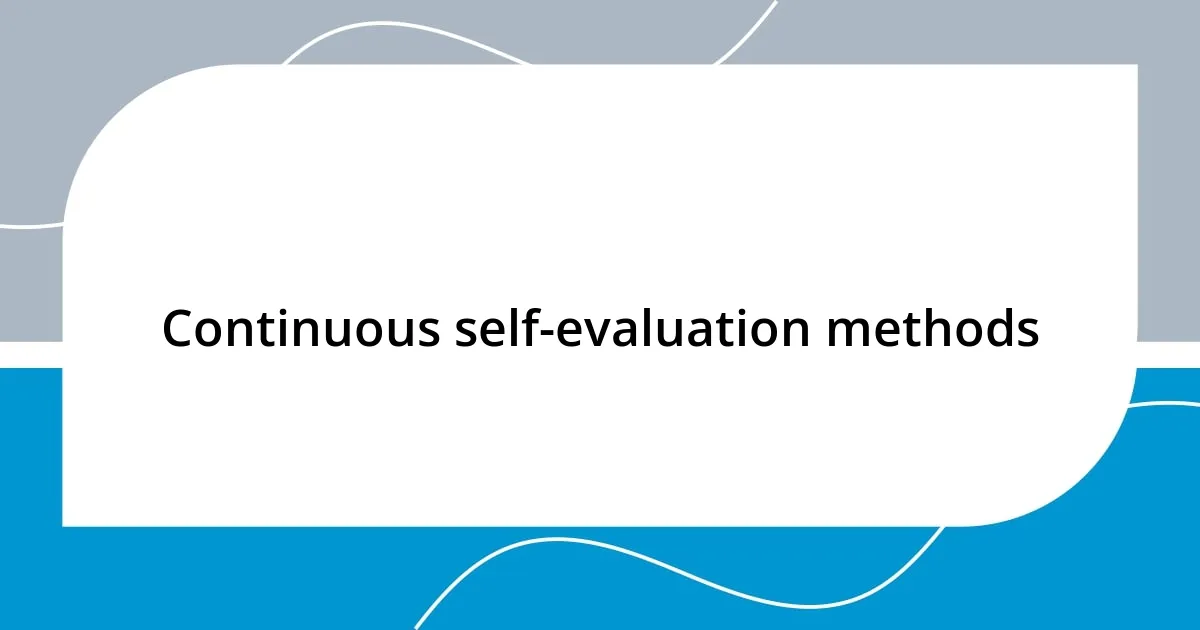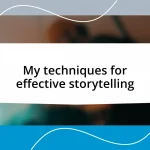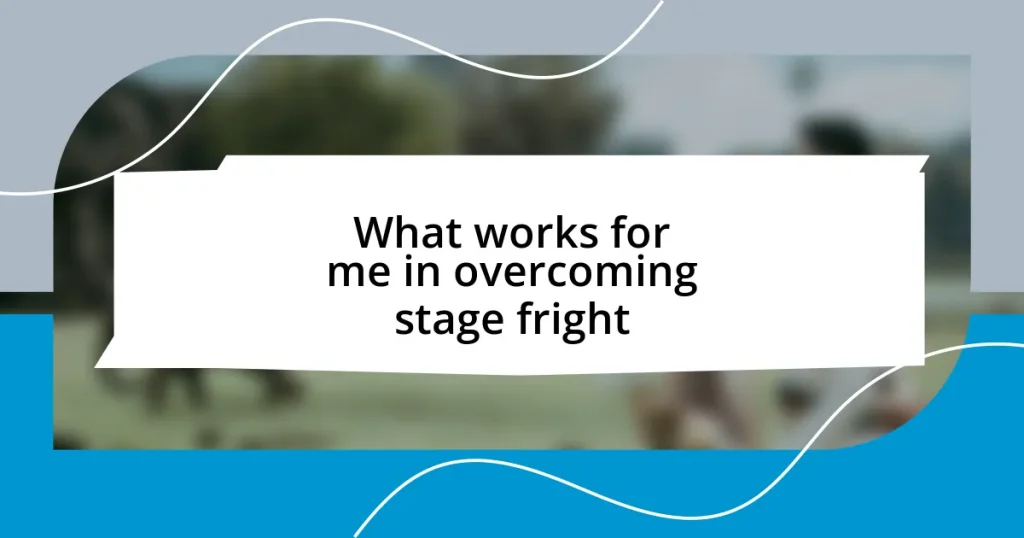Key takeaways:
- Stage presence involves deep audience connection, authenticity, and the ability to read audience reactions.
- Mindfulness techniques like deep breathing and visualization enhance focus and confidence during performances.
- Engaging with the audience through eye contact, participation, and personal stories fosters a dynamic connection.
- Continuous self-evaluation and feedback help refine performance skills and improve stage presence over time.

Understanding stage presence
Stage presence is not just about being seen; it’s about connecting deeply with your audience. I remember a performance where I felt completely at ease. As I locked eyes with a few audience members, I noticed their engagement, and it transformed my energy. Have you ever felt that electric connection? It’s spellbinding; it fuels your confidence and enhances your delivery.
Authenticity plays a huge role in stage presence. I’ve seen performers who try to mimic others, but what resonates is when they embrace their true selves. One time, I let my nerves slip away, and I spoke from the heart about my struggles in a particular performance. That honesty created an unbreakable bond with the audience. Doesn’t it feel refreshing when someone shares their genuine story?
Moreover, being present means being attuned to your surroundings and the audience’s reactions. I often find that pausing to react to laughter or even silence can create a powerful moment. I once performed a piece where I intentionally embraced the silence after a poignant statement, feeling the audience’s anticipation. Have you ever noticed how silence can weave a connection that words sometimes can’t? It’s a dance, maintaining that balance between leading and following the audience’s energy.

Practicing mindfulness techniques
Practicing mindfulness techniques helps me stay grounded on stage. One of my go-to methods is focusing on my breath before stepping into the spotlight. Just a few deep breaths calm my racing heart and sharpen my awareness. Have you ever noticed how changing your breathing can shift your mindset dramatically?
I also practice visualization techniques, picturing a successful performance in my mind beforehand. This practice creates a mental blueprint that guides me in real-time. I remember a particularly nerve-wracking show where, just before going on stage, I visualized myself connecting deeply with the audience. That mental image anchored me, and I felt a profound connection during my performance.
Additionally, body awareness is crucial for maintaining presence. I pay attention to how my feet settle into the ground and how my posture reflects confidence. There was a moment in a performance where I consciously adjusted my stance, and it felt like a surge of energy flowed through me. Did you ever realize how your body’s language speaks volumes, even before you utter a word?
| Technique | Description |
|---|---|
| Deep Breathing | Engaging in several deep, intentional breaths to calm nerves and enhance focus. |
| Visualization | Creating a mental picture of a successful performance to boost confidence and clarity. |
| Body Awareness | Being conscious of posture and physical presence to project confidence and energy. |

Breathing exercises for focus
Breathing exercises have been a game-changer for my focus on stage. Whenever I feel the familiar twinge of anxiety creeping in, I turn to deep breathing. It’s amazing how taking those moments to breathe intentionally can ground me. Just recently, during a highly charged performance, I paused to take a few deep breaths backstage. The swirling thoughts receded, and I felt more present, allowing me to connect genuinely with the audience. It’s a small act that has a profound impact.
Here are some effective breathing techniques I recommend for enhancing focus:
- Diaphragmatic Breathing: Inhale deeply through your nose, allowing your diaphragm (not just your chest) to expand fully. This engages your entire respiratory system.
- 4-7-8 Breathing: Inhale for 4 seconds, hold for 7 seconds, and exhale slowly for 8 seconds. This slows your heart rate, creating a calming effect.
- Box Breathing: Inhale for 4 seconds, hold for 4 seconds, exhale for 4 seconds, and hold the exhale for another 4 seconds. This technique helps regain control over your breath and mind.
- Breath Counting: As you inhale and exhale, count each breath up to 10, then start over. This brings your focus back and keeps your thoughts from wandering.
Incorporating these techniques can turn moments of stress into opportunities for clarity. I’ve often found that a few focused breaths right before I step on stage not only steadies me but also enhances my awareness of the audience’s energy, allowing for a truly immersive performance.

Engaging with the audience
Engaging with the audience is one of the most fulfilling parts of performing. I often make eye contact with different people in the crowd, which creates an immediate sense of connection. In a recent show, I spotted a young girl in the front row who was totally absorbed in the performance; that sight lit up a spark in me. As I continued, I found myself playing for her, drawing energy from her enthusiasm. Have you ever felt how a simple gaze can transform the dynamic between performer and audience?
Another strategy I use is encouraging audience participation. Prompting them to clap, sing along, or even respond to questions can drastically elevate the energy in the room. There’s something exhilarating about feeling the audience’s collective heartbeat sync with my own performance. I remember one concert where I asked the crowd to join in on a chorus, and the overwhelming response of laughter and cheer made me feel unstoppable. It’s like sharing a pulse with the room—magnificent and exhilarating!
To further enhance this connection, I weave in personal stories and anecdotes relevant to the theme of my performance. When I share something authentic, I see how it resonates with individuals in the audience. I once told a funny mishap from my early days on stage, and the laughter that erupted felt like a warm embrace—binding us all together in that moment. Isn’t it wonderful how shared laughter can break down walls and invite everyone into a shared experience?

Maintaining body language awareness
Maintaining awareness of my body language is crucial to delivering an engaging performance. I’ve realized that where I place my hands, how I position my feet, and even my facial expressions communicate just as much as my words. For instance, during a recent play, I noticed that my tendency to fold my arms made me appear closed off to the audience. A quick adjustment to open my stance not only changed how I felt but seemed to brighten the room instantly. Have you ever caught yourself clenching your fists or shifting your weight nervously? It’s fascinating how small shifts in posture can lead to larger shifts in energy.
I often remind myself to be intentional with my gestures. When I speak about something passionate, I use expansive hand movements to amplify my message, creating a visual representation of my excitement. There was a moment during a storytelling event where an intricate weave of my hands helped illustrate a tale about a wide river. The audience leaned in, captivated—not just by my words, but by my physical embodiment of the story. It’s remarkable to see how body language can draw people into your narrative, isn’t it?
I also constantly check in with the audience’s response to my nonverbal cues. If I sense disengagement, I make a conscious effort to adapt my stance, engaging my core and straightening my back to emit more confidence and energy. One time, in a more quiet setting, I noticed a few people checking their phones. Instead of panicking, I took a deep breath, altered my posture, and leaned slightly forward, inviting them back into the space. Instantly, their eyes returned to me, and the room felt alive again. This interplay of body language not only keeps my presence strong but also fosters a genuine connection. How do you ensure your presence resonates with those around you?

Using visualization strategies
Using visualization strategies has become an essential part of my performance preparation. Before stepping on stage, I take a moment to close my eyes and visualize the space, the audience, and myself. Picture this: I imagine a bright spotlight highlighting me while the crowd smiles and cheers, their faces radiating warmth. This mental imagery not only calms my nerves but also fuels my confidence. Have you ever envisioned your ideal performance and actually felt the excitement building?
I also employ visualization to mentally rehearse my transitions and cues throughout the performance. In a recent theater production, I vividly pictured each scene shift, the emotions I wanted to convey, and even the reactions I anticipated from the audience. When I nailed those shifts during the show, I felt an electric connection that was nearly tangible. Isn’t it incredible how a simple mental practice can lead to such actual moments of connection?
Moreover, I use visualization as a tool to overcome potential challenges. One time, I worried about hitting a particularly high note that usually made me anxious. So, I visualized myself not just hitting that note, but owning it—feeling the thrill coursing through me as the audience erupted in applause. When the moment came, I did just that, and the rush was both exhilarating and affirming. Isn’t it fascinating how our minds can transform our fears into triumphs?

Continuous self-evaluation methods
Continuous self-evaluation methods are a game-changer for me when performing. I’ve developed the habit of mentally checking in with myself during a presentation. For instance, after every few lines, I quickly scan my feelings—am I feeling confident, anxious, or something else? This habit not only helps me adjust my energy but also keeps my mind clear and focused. Have you ever paused mid-sentence to reassess your vibe on stage?
After every performance, I sit down with my thoughts and jot down what worked and what didn’t. Reflecting on my body language, my pacing, and the audience’s reactions creates a clear roadmap for improvement. Recently, I noted that I rushed through a heartfelt moment, losing the emotional impact. Next time, I plan to slow down and let the words breathe. It’s wild how that simple acknowledgment can shape the way I approach future performances, don’t you think?
Engaging in regular feedback sessions with trusted peers is another self-evaluation method I swear by. After a lively event, I often ask for their impressions, especially regarding my stage presence. Just last month, a fellow performer told me my energy fluctuated too much during the climax of our piece. Taking that feedback to heart, I experimented with keeping a steadier flow, which infused my performance with a more captivating energy. Isn’t it amazing how outside perspectives can illuminate our blind spots? That exchange not only helps build my confidence but transforms me into a stronger performer.













